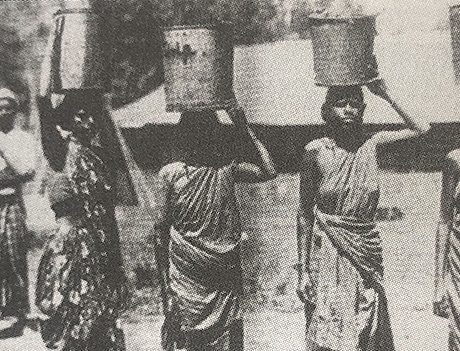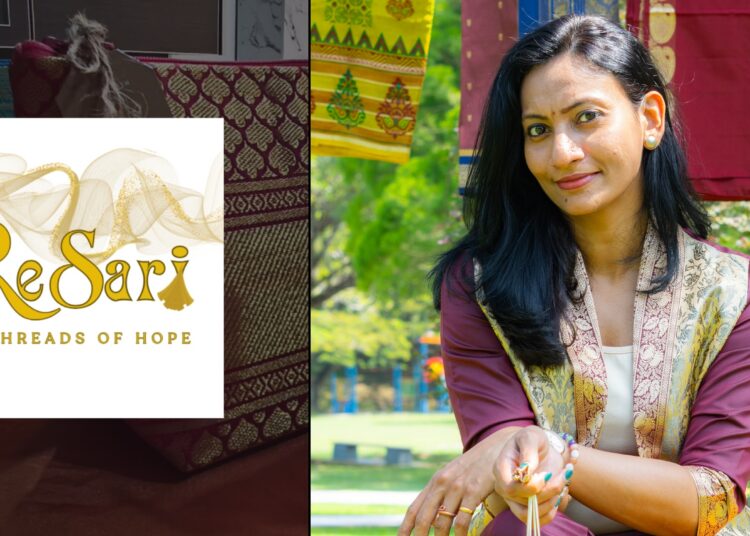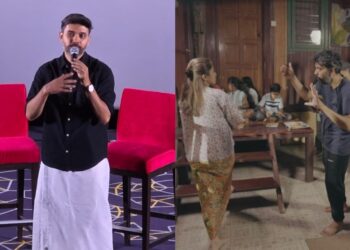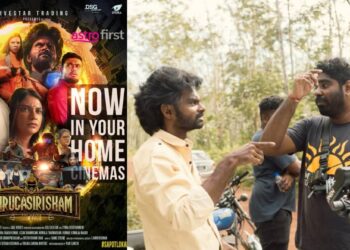“…kappal ēri vantuttēn
en̄kālamē tolaiyilē
nā vanta kappal tirumpalayē”“I boarded the ship
my time never eradicates
the ship I boarded never returned…”– Kālam Vantutun̲n̲u, A Plantation Tamil Folk Song Compiled By Thandayutham, p.173
The first boat to arrive with Tamil indentured labourers arrived nearly 200 years ago on the shores of Malaya. These workers, who came from some of the most oppressed and violently exploited classes of Tamil caste-feudal society, were forcefully brought by the British Imperialists to Colonial Malaya to work on rubber plantations. Nearly four generations have passed, yet there is so much revolutionary and violent histories that Plantation Tamils have endured that is yet to be freed from the abyss of imperialism. While academics have written scholarly texts about the economics and politics concerning Tamil indentured labour and colonialism, these works, while still valuable, are analyses that place the Tamil proletariat at the periphery. The documentary project, Plantation Life: As It Was, directed by Gogularaajan Rajendran and produced by Kumanavannan Rajendran, is an intimate and powerful work that exists as an antithesis to that narrative marginalisation; it instead places the voices of Plantation Tamils at the centre of their own history. The two brothers and creative collaborators express in this interview the interior emotions of this documentary, their creative process, and the power that comes from reclaiming one’s history.
 How did this project begin, and what gravitated you towards creating Plantation Life: As It Was?
How did this project begin, and what gravitated you towards creating Plantation Life: As It Was?
Gogu: This project began as research for my feature film, “Kaali.” Despite my parents having grown up on plantations, I, being a city boy, never truly experienced or embraced plantation life. Whenever we visited my hometown during festivals, I would eagerly anticipate returning to the city, feeling uncomfortable amidst the heat, intensity, loud voices, and overwhelming rituals. Looking back, I realised that I might have unknowingly bought into negative stereotypes about “estate” life, leading me to distance myself from it all. As I matured, I deliberately kept myself distant from Indian people and culture, but I couldn’t fully understand the reason behind my feelings.
At one point, I felt entirely detached and free. However, as an artist, I knew that I couldn’t remain in such a state. An artist is someone who soars into the sky but, at the same time, keeps their roots deep in the soil. I understood that to truly flourish as an artist, I needed to find my roots and immerse myself in them with love and liberty. Yet, a problem persisted – I didn’t know where to find my roots. This realisation saddened me, especially as a Malaysian Indian artist, where our community lacked a rich history of art and a clear sense of identity.
One night, while standing on a side road in KL during a drizzle, I found myself praying to the universe for guidance. I had once asked for solitude, but now I sought help in discovering my roots.
Not long after that, I began writing “Kaali,” a story set on a plantation during the 1960s, focusing on a mother’s experiences. This project became a personal journey of exploring my own origins. Although I initially lacked deep knowledge of plantation life, I relied on my instincts and inspirations to weave the basic dramatic narrative. As the project progressed, I became aware of my limitations. To genuinely understand my characters, I needed to immerse myself in their minds and see the world through their eyes. I had to grasp their psyche, beliefs, fears, and joys.
This led me and my producer, Kuma, to start “Plantation Life” as an immersion project for our film “Kaali.” Thanks to the Krishen Jit Fund, we were able to embark on this exploration. The more I delved into the lives of people in plantations, the more I fell in love with them. It amazed me how understanding and love were intricately connected. Hate, I realised, stemmed from a lack of understanding. Once I truly knew and empathised, divisions disappeared, and unity prevailed. This realisation deepened my connection to my roots and fostered a genuine appreciation for the lives of my ancestors in plantations.
Kuma: It all began as research for our feature film project, a period piece where we sought to delve into the past to understand the lives of plantation workers in the 1960s. Although academic papers and in-depth research articles existed, we noticed a void in the visual representation of their experiences. Driven by this observation, we decided to take it upon ourselves to fill this gap.
Yet, amidst this ambitious endeavour, a deeper yearning emerged – a yearning to uncover my own history and explore the lives of my ancestors. Memories of visiting the plantation where my father grew up served as the only tangible connection to my roots. Through this project, I find myself embarking on a personal journey of rediscovery, rekindling a profound connection to my heritage and roots.
 What made you decide to post about your ongoing research for the documentary on Instagram? How do you view the relationship between social media and the creative process?
What made you decide to post about your ongoing research for the documentary on Instagram? How do you view the relationship between social media and the creative process?
Gogu: During the course of our interviews, we began to realise that the work we were doing was important. It had a significance that surpassed our initial purpose in starting the project. We felt that this work belonged not just to us but to the Indian people as a whole. The lovely individuals we interviewed opened up to us, sharing both intimate and public memories with the hope of passing down their experiences to the next generation.
Originally, the idea behind this project was to create a documentary film based on these interviews. However, we found ourselves with an abundance of valuable material that might not all fit into the final film. These captivating memories and stories deserve to be shared, and we feel the responsibility to do so.
By sharing some of this material along the way, we aim to gradually build the attention and interest of the community towards the project. We believe that by doing so, when our documentary film is completed, it will reach an even wider audience, allowing more people to connect with the rich history and experiences of the Indian community.
The role of social media in the creative process has been evident, particularly in terms of motivation. Witnessing how much people truly care about our history, not just within the Indian community but also among friends from other races, who genuinely want to learn more and know more about Indian history, has been incredibly inspiring. It has fueled our motivation to carry on and complete this project with even more passion and dedication.
Kuma: As filmmakers, our goal is to build and engage an audience for our project. To achieve this, we recognise the significance of proper funding, and crowdfunding seems like the right approach to secure the necessary resources for successful completion. Embracing the power of social media, we have decided to leverage Instagram as a platform to share insights into our research and connect with potential supporters.
Instagram offers a remarkable opportunity to market our idea and connect with a broader audience. Its visual appeal and vast user base make it an ideal avenue to showcase our work and captivate the minds of those interested in our project.
However, while we value the potential of social media, we are mindful that it should not dictate our creative process. Instead, it should complement and enhance it. As filmmakers, our vision and expertise guide our research and development process. Social media serves as an ally to amplify our message and extend our reach, rather than steering us away from our core values and objectives.
We believe that striking the right balance between utilising social media and staying true to our creative process will yield the best results. By harnessing the power of Instagram to ignite curiosity and generate excitement around our idea or product, we aim to foster a genuine sense of community and connect with like-minded individuals who share our passion.
 What were the technical, emotional, and other struggles you faced while filming for this documentary? Besides the film medium, what other ways did you use to document your research (for example, audio, text, etc.)?
What were the technical, emotional, and other struggles you faced while filming for this documentary? Besides the film medium, what other ways did you use to document your research (for example, audio, text, etc.)?
Kuma: The logistics of gaining access to plantations and connecting with the right people proved to be quite challenging. Many times, despite making arrangements and starting our journey, circumstances forced us to cancel our trips.
Additionally, locating individuals within our target age range for interviews posed a significant obstacle. Initially, we had planned to visit five plantations, intending to meet ten people at each location, but the task turned out to be more complex than anticipated. To overcome this hurdle, we decided to post an open call for participants, and the response was overwhelming. People graciously referred us to their parents, grandparents, and friends, expanding our pool of interviewees.
Throughout our venture, we documented the interviews through filming and voice recording, preserving the essence of their stories. Moreover, we diligently scanned old photographs and pertinent documents like temple circulars and wedding invitations. The upcoming phase of our process involves transcribing these interviews and converting them into textual form to further analyse and comprehend the narratives.
Gogu: The biggest struggle in the project was coordinating and arranging meetings with the interviewees. Fortunately, the burden was lifted off my shoulders by my supportive assistant (Deena) and producer (Kuma). My role focuses on envisioning and guiding the project, engaging with the interviewees, and learning about their lives. During the interviews, I find myself genuinely interested in their stories, often abandoning scripted questions to let the conversation flow naturally. I sense a strong desire from them to share stories they’ve carried for a long time.
However, the unscripted nature of the interviews presents a challenge during the editing process. Sorting through a vast amount of footage to find a cohesive narrative thread is difficult, but I’m confident I will discover it. We’ve completed around 60% of our intended interviews and aim to finish production by September. Currently, we’re transcribing interviews and starting paper editing.
Besides filming, we’re immersing ourselves in various sources like journals, novels, research papers, and books about Indians in plantation life. Our exploration of archives and museums has yielded fruitful results. One exciting find was Dr.Thandayuthum’s book on Malaysian Tamil folk songs, which provided poetic and direct insights into the lives of the plantation labourers. We’re exploring every possible medium and outlet to gain a deeper understanding of their past lives.
 As brothers and creatives, the two of you are collaborating on this project. Could you speak on the creative process behind working with each other and the contradictions and understandings you both share? Could you also detail your own personal artistic journeys in the film industry and other creative spaces you have been part of?
As brothers and creatives, the two of you are collaborating on this project. Could you speak on the creative process behind working with each other and the contradictions and understandings you both share? Could you also detail your own personal artistic journeys in the film industry and other creative spaces you have been part of?
Gogu: Working with Kuma was initially challenging, as we had to find a common language to share ideas. Communication efficiency remains a work in progress since we have different goals and tastes. I believe this is the same with anyone. Human interactions are inherently messy, but the beauty lies in attempting to understand and respectfully convey our fragile ideas to each other. I view Kuma not just as a brother but as a valued collaborator I can trust wholeheartedly, despite our many dissimilarities.
I’ve always believed humour is my language. I started my filmmaking journey by creating satire videos on YouTube under the channel Naarasimma. Aspiring to master comedy, I have developed two feature-length comedy ideas. However, everything changed when I became involved in developing the Kaali project. Unlike my previous lo-fi comedy projects, Kaali required me to grow and tackle serious topics. It demanded personal growth and transformation, challenging me to become a better version of myself. This process excites me, as I look forward to discovering the person I’ll evolve into.
Mr. Shanjey’s debut film, “Jagat,” had a profound impact on me, opening my eyes to the possibilities of truthfully sharing the Malaysian Tamil experience through cinema. It inspired me to dream of honest Malaysian Tamil Cinema, something I previously had no idea ever existed.
Fortunately, I had the opportunity to work as an assistant director with Mr. Shanjey Kumar on his second film, “Neer Mel Neruppu”. As someone who never attended film school, this collaboration was enlightening. Mr. Shanjey’s willingness to share his wisdom without bias or limitations created an open and inspiring atmosphere. This experience not only boosted my confidence as an artist but also contributed to my growth as a good human being on a holistic level.
Besides Mr. Shanjey, my creative journey has been enriched by numerous generous mentors who have profoundly inspired me. Participating in various programmes organised by the Seashorts Film Festival has provided me with valuable tools to develop my art. One notable experience was last year’s Mylab, a development lab, where we worked intensively on our script and learned immensely from our incredible mentors: Marie Dubas, Marten Rabarts, and Anurag Kashyap.
Kuma: Film is a collective art, and collaboration has always been a big part of my journey as a filmmaker. Working with Gogu, I’ve come to appreciate the healthy balance of similarities and differences in our tastes and working styles. As a producer, it’s my utmost priority to protect the director’s vision, and I genuinely believe in and respect Gogu’s ability to tell this story in his unique visual and cinematic voice.
My venture into video and film production started back in 2010, and since then, I’ve mostly worked as a freelancer. Over the years, I’ve had the opportunity to experience various roles both on and off-set, which has given me a well-rounded understanding of the filmmaking process. Currently, alongside this documentary project, I’m thrilled to be developing both a short film and a feature film, allowing me to explore my passion for storytelling further.
I find immense value in the collaborative nature of film production. Partnering with Gogu and embracing his distinctive artistic approach, we create an environment that fosters creativity and encourages each other’s unique contributions. Our complementary skills and perspectives enrich the creative process, ensuring that the final product is an authentic representation of our collective vision.
As a filmmaker, I understand the ever-changing landscape of the industry, and I’m excited about the challenges and opportunities it presents. With my experience and Gogu’s artistic voice, I am confident that the projects we undertake will captivate audiences and leave a lasting impact.
 The project documents the history of the Tamil labourer and Tamil labour in Southeast Asian lands. The semantics of the term Plantation Tamil itself is already the synthesis of two landscapes and two consciousnesses, of both the Plantation and the Tamil. You have expressed the necessity in Malaysian Tamil cinema of creating a unique artistic expression that neither mimics Kollywood nor dilutes the Tamil elements of Plantation labourers. How have you witnessed this process of this new language and anatomy of film forming through your project? Could you speak about the collision of these complex landscapes of Tamil, Malaysian, Plantation, Diaspora, and Land?
The project documents the history of the Tamil labourer and Tamil labour in Southeast Asian lands. The semantics of the term Plantation Tamil itself is already the synthesis of two landscapes and two consciousnesses, of both the Plantation and the Tamil. You have expressed the necessity in Malaysian Tamil cinema of creating a unique artistic expression that neither mimics Kollywood nor dilutes the Tamil elements of Plantation labourers. How have you witnessed this process of this new language and anatomy of film forming through your project? Could you speak about the collision of these complex landscapes of Tamil, Malaysian, Plantation, Diaspora, and Land?
Gogu: I made a deliberate effort to sober my mind from the conditioning of South Indian cinema, which has influenced me for years. There is a huge gap between what we consume through entertainment and what’s actually happening here in our lives. I found it easier to focus on telling my ideas without giving excessive importance to style and form. When we honestly convey a story, the form naturally evolves. There is no need to worry about originality. This new language of storytelling I’m discovering is closely tied to my identity and my unique way of seeing the world around me.
During our initial research, we intended to highlight the mundane and humorous moments of plantation labourers’ lives. As the struggles of our community have been extensively documented, we wanted to shed light on the simpler and gentler aspects that have gone unnoticed. However, during the interviews, we were confronted with overwhelming pain repeatedly. These individuals have experienced significant traumas in their lives. Only after expressing their pain did the interviewees feel comfortable discussing the beauty and vibrancy that also exists in plantation life.
I believe this will be the essence of my expression – confronting both the trauma and beauty of plantation life, capturing both the intense and mundane aspects. It’s about embracing the full spectrum of emotions and experiences these individuals have endured, and showing the Tamils as complex human beings capable of darkness and divinity.
The repeating themes in the lives of Tamils in Malaysia are displacement and yearning. In the past, our community enjoyed a culturally rich and communal life in India, where agriculture was a collective endeavour. However, when Tamil labourers were brought to this foreign land, they had to abandon the richness of their life in India and start anew from scratch. It is intriguing to observe how the Tamils have managed to impose their culture, beliefs, and deities on this new land, creating a sense of familiarity. I feel that, though the Tamils now have come to accept Malaysia as their home, there is still the wound of displacement, and we are still yet to wholly embrace Malaysia as our motherland.
 The Plantation Tamils have lived through many political changes that have occurred, from witnessing Malaya as a colony to the formation of Malaysia as a supposedly independent post-colony. Yet through all these political, economic, and social transformations, the Plantation Tamil has experienced poverty, violence, and humiliation from generation to generation. Your work centralises the generation that experienced the first decade of a postcolonial society. What truths has your work revealed to you about this cycle of oppression? How have your political views differed or remained the same since you started working on this project?
The Plantation Tamils have lived through many political changes that have occurred, from witnessing Malaya as a colony to the formation of Malaysia as a supposedly independent post-colony. Yet through all these political, economic, and social transformations, the Plantation Tamil has experienced poverty, violence, and humiliation from generation to generation. Your work centralises the generation that experienced the first decade of a postcolonial society. What truths has your work revealed to you about this cycle of oppression? How have your political views differed or remained the same since you started working on this project?
Gogu: Even after independence, the Tamils continued to be managed similarly to the colonial times. European estate managers remained involved in Malaysian plantations, and the political direction and policies of Malaysia did not undergo significant shifts from the colonial period to benefit the Indians.
As indentured labourers, the Tamils were seen as mere tools for profit and deliberately dehumanised. The oppression they faced was evident in every aspect of plantation life. From the regimental morning roll-call to the hierarchical divisions based on caste, from the promotion of toddy consumption to destroy their consciousness to the extremely small and substandard housing, and from being kept separate from the development of the new nation to limited access to education, everything was cunningly designed to strip away their self-respect and dignity, keeping them as ignorant slaves. Sadly, many Tamils were unaware of the extent of their oppression, as they were kept comfortable enough not to revolt.
It is indeed heartbreaking to see the lasting impact of the oppressive system on Tamil communities even today. Despite advancements in wealth, the chains of oppression have not been fully broken. The slave mentality still persists, hindering our ability to realise our true potential and independence. In the realm of arts, we continue to be enslaved to the influences of South Indian cinema and Hollywood, preventing us from exploring the true meaning of our existence in this land. I think when the Malaysian Tamils watch themselves represented truthfully in cinema, one step towards finding our identity would be taken. We must reclaim our narrative; that is our liberation!
 What would you like this project to accomplish?
What would you like this project to accomplish?
Kuma: We embarked on this project not only as research for our film but also as a means to preserve the stories of our ancestors for future generations. It’s a fulfilling accomplishment to imagine today’s children learning valuable lessons about the past through our efforts.
The departure of Indian Malaysians from plantations began in the late 1980s, with foreign workers rapidly taking their place. Unfortunately, the older generation lacked the luxury of documenting their lives, and those within our target age group are now well into their 60s and 70s. If we fail to treasure their stories now, they will be lost forever. Our completion of this project allows us to capture the essence of a generation that contributed tirelessly to building our nation. This fact is often overlooked, but we take pride in voicing it louder than ever before.
While it may be hopeful thinking, we also see our project as an inspiration for artists and scholars to conduct their own research from various perspectives. In that sense, any pursuit that stems from our work is considered a victory we happily embrace.
All Images Provided By Gogularaajan Rajendran
Follow us on Instagram, Facebook or Telegram for more updates and breaking news.








